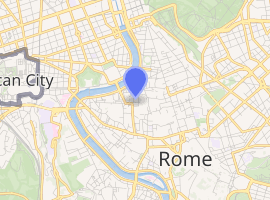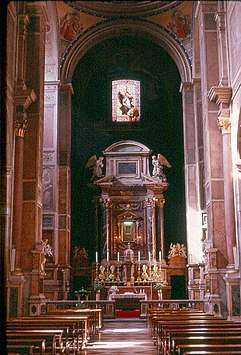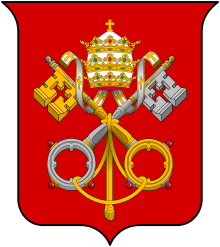Sant'Agostino, Rome
The Basilica of St. Augustine in Campo Marzio (Italian: Basilica di Sant'Agostino in Campo Marzio; Latin: Basilica Sancti Augustini in Campo Marzio), commonly known as Basilica of St. Augustine and locally as Sant'Agostino, is a catholic titular minor basilica dedicated to Saint Augustine in Rome, Italy. It is the mother church of the Order of Saint Augustine and it is located near the Piazza Navona in the rione Sant'Eustachio.
| Basilica of St. Augustine | |
|---|---|
| Basilica of St. Augustine in Campo Marzio | |
 Façade of the church from the Piazza | |

| |
| 41°54′3.24″N 12°28′27.44″E | |
| Location | Rome |
| Country | Italy |
| Denomination | Catholic |
| Religious institute | Order of Saint Augustine |
| Website | www |
| History | |
| Former name(s) | Church of St. Tryphon in Posterula Church of St. Tryphon and Augustine |
| Status | Minor basilica |
| Founded | 1286 |
| Founder(s) | Pope Boniface VIII Guillaume d'Estouteville |
| Dedication | Augustine of Hippo Tryphon |
| Consecrated | 1446 |
| Cult(s) present | Saint Augustine Saint Monica Madonna del Parto |
| Relics held | Saint Monica Saint Tryphon |
| Architecture | |
| Functional status | Active |
| Architect(s) | Giacomo di Pietrasanta Francesco Borromini Baccio Pontelli Luigi Vanvitelli Carlo Murena |
| Style | Roman renaissance |
| Groundbreaking | 1296 |
| Completed | 1446 |
| Administration | |
| Diocese | Diocese of Rome |
| Clergy | |
| Cardinal protector | Jean-Pierre Ricard |
| Priest in charge | Felice Perrino |

First conceived in 1286, where a primitive 8th-century church dedicated to St. Tryphon of Campsada was located, the basilica is known for its roman renaissance architecture style, artwork by artists such as Caravaggio, Raphael, Guercino and Bernini, and for being the burial place of Saint Monica (d. 387), mother of Saint Augustine of Hippo.
History
The Order of St. Augustine was founded in 1244 and its first church and monastery were the ones of Santa Maria del Popolo next to the Porta del Popolo on the Roman wall. The friars of the newly founded mendicant order, however, desired to have their main house closer to the Pope and the administration of the Church.[1]
In 1286, a Roman nobleman named Egidio Lufredi donated several houses in the area of Campo Marzio to the Order. The friars requested authorization to construct a church and a monastery on this land; Pope Honorius IV, however, only authorized the construction of the monastery because a new church would be too close to the Church of St. Tryphon in Posterula, at the corner of the current Via dei Portoghesi and Via della Scrofa. Instead, the Pope entrusted the already existing church, which preserved the relics of martyrs Saints Tryphon, Respicius, and Nympha, to the Augustinians.[1]
The construction of the church was funded by Guillaume d'Estouteville, Archbishop of Rouen and Cardinal Camerlengo (1477-1483).[2] The façade was built in 1483 by Giacomo di Pietrasanta, using travertine taken from the Colosseum. The design of the church is attributed to the late 15th century architect Baccio Pontelli, with later 18th century restorations of the interior by Luigi Vanvitelli.[3] It is a plain work of the early Renaissance style.[4]
The Titulus S. Augustini has been held by Cardinal Jean-Pierre Ricard since 2006. Furthermore, it is the station church of the first Saturday in Lent.
Artwork
_September_2015-1.jpg)
A very prominent work of art presently in the church is the Madonna di Loreto in the Cavalletti Chapel (first chapel on the left), an important early Baroque painting by Caravaggio.[5]
The church also contains a Guercino canvas of Saints Augustine, John the Evangelist and Jerome; a fresco of the Prophet Isaiah by Raphael on the third pilaster of the left nave[6]; and the statue of Saint Anne and Virgin with Child, by Andrea Sansovino.
The sculpture of the Madonna del Parto (Our Lady of Childbirth) by Jacopo Sansovino based, according to a legend, on an ancient statue of Agrippina holding Nero in her arms, is reputed by tradition to work miracles in childbirth. The statue is laden with thank-offerings and always surrounded by offerings of flowers and candles.
In 1616, the 17th-century Baroque artist Giovanni Lanfranco decorated the Buongiovanni Chapel (in the left transept) with three canvases and a ceiling fresco of the Assumption.
The church also houses Melchiorre Caffà's sculpture "St. Thomas of Villanova Distributing Alms", completed by his mentor Ercole Ferrata.
Tombs
The church contains the tomb of Saint Monica, mother of Saint Augustine, that of Fiammetta, lover of Cesare Borgia and a famous courtesan, and that of Olav Trondsson, archbishop of Norway 1459 - 1473. His tombstone has the inscription "CVI DEDERAT SACRAM MERITO NORVEGIA SEDEM HIC TEGIT OLAVI FRIGIDVS OSSA LAPIS", meaning: "Here a cold stone covers the bones of Olav, to whom Norway rightly gave the holy chair."[7]
The inscriptions found in S. Agostino, a valuable source illustrating the history of the church, have been collected and published by Vincenzo Forcella.[8]
In 1741, Pietro Bracci designed and sculpted the polychrome tomb of Cardinal Giuseppe Renato Imperiali, who died on 15 January 1737.[9]
Guillaume d'Estouteville (c. 1412–1483), a leading bishop and cardinal, also is buried here.
List of Cardinal-Protectors
Pope Sixtus V (1585-1590) established the titular church of a cardinal priest in April 1587.
- Gregorio Petrocchini, OESA, (23 March 1590–28 May 1608)
- Fabrizio Veralli, (10 December 1608–17 November 1624)
- Berlinghiero Gessi, (19 July 1627–6 April 1639)
- Ottaviano Raggi, (10 February 1642–31 December 1643)
- Niccolò Albergati-Ludovisi, (24 April 1645–25 June 1646)
- Fabrizio Savelli, (16 December 1647–26 February 1659)
- Antonio Bichi, (1 December 1659–14 November 1667)
- Federico Borromeo (iuniore), (23 February 1671–8 August 1672)
- Francesco Lorenzo Brancati di Lauria, (22 September 1681–1 December 1681)
- Carlo Stefano Anastasio Ciceri, (7 July 1687–24 June 1694)
- Enrico Noris, OESA, (2 January 1696–23 February 1704)
- Carlo Agostino Fabroni, (25 June 1706–19 September 1727)
- Angelo Maria Quirini, OSB Cas., (22 December 1727–8 March 1728)
- Gregorio Selleri, OP, (10 May 1728–31 May 1729)
- Marco Antonio Ansidei, (6 July 1729–14 February 1730)
- Bartolomeó Massei, (8 January 1731–20 November 1746)
- Giorgío Doria, (15 December 1745–3 January 1757; 3 January 1757–31 January 1759)
- Gaetano Fantuzzi Gottifredi, (19 November 1759–6 April 1767)
- Mario Marefoschi Compagnoni, (12 December 1770–23 December 1780)
- Paolo Massei, (11 April 1785–9 June 1785)
- Diego Innico Caracciolo Di Martina, (20 October 1800–26 September 1814; 26 September 1814–24 January 1820)
- Cesare Brancadoro, (29 May 1820–12 September 1837)
- Friedrich Johannes Jacob Celestin von Schwarzenberg, (27 January 1842–27 March 1885)
- Antolín Monescillo y Viso, (10 June 1886–11 August 1897)
- Antonio María Cascajares y Azara, (24 March 1898–27 July 1901)
- Sebastiano Martinelli, OESA, (9 June 1902–4 July 1918)
- Aleksander Kakowski, (18 December 1919–30 December 1938)
- Agustín Parrado y García, (22 February 1946–8 October 1946)
- Fernando Quiroga y Palacios, (29 October 1953–7 December 1971)
- Marcelo González Martín, (5 March 1973–25 August 2004)
- Jean-Pierre Ricard, (24 March 2006– present)
See also
- Burials at the Basilica of Sant'Agostino
References
| Wikimedia Commons has media related to Sant'Agostino (Rome). |
- "Rome - Sant'Agostino Church". Augnet. Retrieved 3 May 2020.
- S. Miranda, list of Cardinal Chamberlains of the Holy Roman Church. Retrieved: 2016-03-21.
- New Guide of Rome, Naples and Their Environs, By Mariano Vasi and Antonio Nibby, page 105.
- Rendina, Claudio (2000). La grande enciclopedia di Roma. Rome: Newton Compton.
- John Varriano, Caravaggio: The Art of Realism (University Park, PA: Penn State Press, 2010), pp. 44-46. John T. Spike, Caravaggio: Catalogue of Paintings (New York-London: Abbeville Press, 2010), pp. 148-150.
- Restored by Daniele da Volterra, as quoted in A Handbook of Rome (1871), page 128.
- Fjellbu, A., et al. (eds.) (1955). Nidaros erkebispestol og bispesete 1153 - 1953. Oslo, Land og kirke. Forcella, p. 15, no. 31.
- V. Forcella, Inscrizioni delle chiese e d' altre edifici di Roma, dal secolo XI fino al secolo XVI Volume V (Roma: Fratelli Bencini, 1875), pp. 1-112. [in Italian and Latin]
- Forcella, p. 103, no. 307.
Bibliography
- P Antonino Ronci and D. Torre, S. Agostino in Campo Marzio, Roma (Roma: D. Torre, [1950?]).
